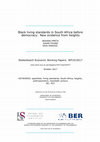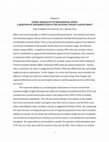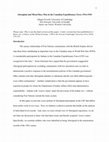Articles and chapters by Kris Inwood
LSE Economic History Working Paper #292, 2018
Little evidence is available to assess the effect of substituting occupation-based income scores ... more Little evidence is available to assess the effect of substituting occupation-based income scores for individual incomes before 1940. The example of immigrant assimilation in Canada 1911-1931 reveals differences in the extent and even the direction of assimilation depending on whether income scores are used and how the occupational income score is constructed. Given the increasingly wide use of income scores, we summarize a number of procedures to address the limitations associated with the absence of individual level income variation. An adjustment of conventional income scores for either group earnings differences and/or intertemporal change using summary information for broad groups of occupations reduces the deviation between scores and actual incomes.

South African Journal of Science, 2018
Very little income or wage data was systematically recorded on the living standards of South Afri... more Very little income or wage data was systematically recorded on the living standards of South Africa’s black majority during much of the twentieth century. This paper uses four data sets to document, for the first time, an alternative measure of living standards: the stature of black South Africans over the course of the twentieth century. We find evidence to suggest that the first three decades of the century were particularly bad, perhaps due to the increasingly repressive labour policies in urban areas and famine and land expropriation that weighted especially heavily on the Basotho. The decade following South Africa’s departure from the gold standard, a higher international gold price and the demand for manufactured goods from
South Africa due to the Second World War seem to have benefited both black and white South Africans. The data also allow us to disaggregate by ethnicity within the black population group, revealing levels of inequality within race group that has been neglected in the literature. Finally, we compare black and white living standards, revealing the large and widening levels of inequality that characterised twentieth-century South Africa.
Published in revised form as “Black living standards in South Africa before democracy: New evidence from heights”, South African Journal of Science 114 (2018): 1-8.
Advances in Artificial Intelligence, Proceedings of 30th Canadian Conference on Artificial Intelligence, 2017
In this paper, we present a method, that uses domain knowledge, to automatically discover and ass... more In this paper, we present a method, that uses domain knowledge, to automatically discover and assign household identifiers to individual historical records. We apply this algorithm on a full count real census (the 1891 Canadian census) to assign household identifiers to all the records.
European Review of Economic History, 2016
This paper uses Canadian census data from 1911 to 1931 to trace the labour market assimilation of... more This paper uses Canadian census data from 1911 to 1931 to trace the labour market assimilation of immigrants up to the onset of the Great Depression. We find that substantial earnings convergence between 1911 and 1921was reversed between 1921 and 1931, with immigrants from Continental Europe experiencing a sharp decline in earnings relative to the native-born. The effect of Depression labour market conditions was particularly pronounced among older immigrants with long tenures in Canada.

The Economic History Review, 2016
ABSTRACT This article examines the health and height of men born in England and Wales in the 1890... more ABSTRACT This article examines the health and height of men born in England and Wales in the 1890s who enlisted in the army at the time of the First World War, using a sample of recruits from the army service records. These are linked to their childhood circumstances as observed in the 1901 census. Econometric results indicate that height on enlistment was positively related to socio-economic class, and negatively to the number of children in the household in 1901 and the proportion of household members who were earners, as well as to the degree of crowding. Adding the characteristics of the locality has little effect on the household-level effects. However local conditions were important; in particular the industrial character of the district, local housing conditions, and the female illiteracy rate. These are interpreted as representing the negative effect on height of the local disease environment. The results suggest that changing conditions at both household and locality levels contributed to the increase in height and health in the following decades.
Australian Historical Studies, 2016
The digitisation of a large number of First World War personnel files in different countries perm... more The digitisation of a large number of First World War personnel files in different countries permits novel big data analyses that contribute in important ways to the histories of the British Empire and of individual countries including Australia. Mass digitisation is very recent; we are only beginning to realise the power of the new resources. In this article we
highlight recent use of First World War datasets for non-First World War research questions as an example of the potential uses of big data for historians. Much of the new research considers aspects of living standards and health that are not accessible from other sources.

Proceedings of the 2016 IEEE Data Mining Workshop (ICDMW), 2016
Record linkage is the process of identifying and linking records that refer to the same entities ... more Record linkage is the process of identifying and linking records that refer to the same entities across several databases. In this paper we integrate three historical data sources (Canadian soldiers in the Canadian Expeditionary Force (CEF) who served in World War I, CEF casualties of World War I, and the Canadian census of 1901) to study the Canadian soldiers and casualties of World War I. We link the soldiers dataset to the casualties one to be able to identify the soldiers that died in WWI. In addition, we link the soldiers dataset to the Canadian census of 1901 to enrich the available attributes. The goal is to generate longitudinal data about the Canadian soldiers that would allow researchers to perform a systematic analysis of who lived and who died. The imprecision of historical data, along with the unavailability of expert links and a limited number of attributes make the linkage process a challenging task. We present in this paper methodology to integrate the three data sources and a preliminary analysis of the longitudinal data.
In Data Integration and Applications Workshop Proceedings, in conjunction with IEEE ICDM, Barcelona, Spain, 2016.
The Future of Historical Demography, 2016
pp 63-66 in The Future of Historical Demography (Leuven/Den Haag: Acco Publishers, 2016), ed. K. ... more pp 63-66 in The Future of Historical Demography (Leuven/Den Haag: Acco Publishers, 2016), ed. K. Matthijs, S. Hin, H. Matsuo and J. Kok, eds.
History of the Family 20 n2 (2015): 159-162

Sport Through the Lens of Economic History, 2016
Ethnic and racial inequality is visible in many professional sports. Recruitment and salary discr... more Ethnic and racial inequality is visible in many professional sports. Recruitment and salary discrimination against African- Americans in basketball, football and baseball has attracted considerable attention (Kahn 1991), as has potential discrimination against Francophones (or French- Canadians) in the premier North American ice hockey league, the National Hockey League (NHL). A significant literature evaluates NHL club and customer culture and its contribution to apparent discrimination against French- Canadians, who comprise an important ethnic and linguistic minority in Canada and a longstanding source of professional hockey players. Lavoie (2003), for example, points to lower draft ranking for French- Canadians despite higher subsequent NHL point- per- game productivity. Among other conclusions, he rejects a suggestion by Walsh (1992) that differential size and weight might provide an explanation. In this chapter we review this literature and reconsider the influence of body size with new evidence that takes account of long- term changes and regional differences in the size and weight of players and the populations from which they are drawn.
We revisit this debate by considering the implications of recent research that examines height, weight and body mass index for Canadians (Cranfield and Inwood 2015) and Canadian-born professional hockey players who played from 1909 to 2010 (Ross, Cranfield and Inwood submitted). Over the last century Quebec- born players in the sample have been consistently smaller and lighter than those born in Ontario and the West, even when controlling for other variables, exactly as suggested by Walsh (1992). By considering the characteristics including the physical size of regional populations from which Canadian athletes are drawn, we can situate the selection process within a larger process of regional recruitment favoring Western Canadian and Ontario players over Quebeckers and Atlantic Canadians. We argue that it is most useful to consider the question of discrimination since 1970, the era of the open draft for amateur entry into the NHL. New evidence for drafted players in this period is consistent with Walsh’s initial premise and provides the basis for a reconsideration of the fundamental sources of ethnic inequality in North American professional ice hockey.
A History of the Global Economy: 1500 to the Present, 2016
pp 274-278 in J. Baten, ed., A History of the Global Economy: 1500 to the Present (Cambridge Univ... more pp 274-278 in J. Baten, ed., A History of the Global Economy: 1500 to the Present (Cambridge University Press 2016)
pp 3-16 in Lives in Transition: Longitudinal Analysis from Historical Sources (McGill-Queens Univ... more pp 3-16 in Lives in Transition: Longitudinal Analysis from Historical Sources (McGill-Queens University Press 2015). ed. P. Baskerville and K. Inwood. ISBN: 9780773544673

Lives in Transition: Longitudinal Research from Historical Sources, 2015
The uneasy relationship of First Nations communities with the British Empire did not stop them fr... more The uneasy relationship of First Nations communities with the British Empire did not stop them from contributing in important ways to the Canadian army in World War One (WWI). A considerable participation by Indians in the Canadian Expeditionary Force (CEF) was recognized at the time. Some historians have argued that the government exaggerated Aboriginal participation by excluding communities with low attestation rates in order to demonstrate a positive response to the assimilationist policies of the Canadian government. Other scholars note that Aboriginal attitudes to enlistment and the war effort differed greatly – even within communities. Another complication is that the government appears to have reported on people for whom the Department of Indian Affairs (DIA) had administrative responsibility – Indians with ‘reserve status’ under the provisions of the Indian Act – without considering First Nations outside the treaty system.
In this paper we provide a new portrait of Aboriginal participants in the CEF that differs from earlier work in two ways. First, we fashion a collective portrait that builds on the analysis of individual-level records. And, since we seek a broad view of Aboriginal experience, we do not limit our discussion to those who had taken treaty and thereby acquired ‘reserve status’. Specifically, we examine soldiers who were identified as being Aboriginal in the enumeration records of the 1901 census. The link between the census and military records allows us to identify differences in participation by tribal group, region and mixed race versus pure blood. We see evidence of a considerable diversity of Aboriginal experience in the CEF, as historians have argued. The new evidence also suggests that Aboriginal contribution was even more extensive than originally claimed by the government because some mixed race communities participated more actively than those with reserve status.

We use newly compiled evidence on inter- and intra-continental shipping costs to investigate the ... more We use newly compiled evidence on inter- and intra-continental shipping costs to investigate the relationship between transport costs and trade volumes for the trans-Atlantic iron trade from 1870-1913. Although we find a surprisingly weak connection linking ocean freight rates to British export volumes, when we control for endogeneity, and measure the full range of transport costs - including overland rail charges, insurance, wharfage and brokerage fees - for the inter-continental shipment of pig iron and the intracontinental assembly of raw materials, the importance of transportation strongly asserts itself. During the late-nineteenth and early-twentieth centuries, the cost to transport pig iron across the Atlantic ocean, and the cost to move iron ore and coking coal to North American blast furnaces, were important determinants of the volume of British iron shipments to North America.
Journal of Economic History 75 (2015): 95-124
Population Reconstruction, 2015
This chapter builds on a recent use of SVM classification to create linked
sets of Canadian 1871 ... more This chapter builds on a recent use of SVM classification to create linked
sets of Canadian 1871 and 1881 census records. The census data are imprecise and
have limited granularity; many records share identical detail. In spite of these
challenges, the SVM generates life-course information for large numbers of individuals
with a low (3 %) false positive error rate. However, there is a higher incidence
of error among apparent migrants when the true rate of migration is small. The
linked data are broadly representative of the population with some underrepresentation
of illiterates, young adults (especially unmarried women), older people
(especially men), and married people of French origin. The new longitudinal data are
of considerable research value but users must take into account these weaknesses.

The history of the family : an international quarterly, 2015
The British colonization of New Zealand after 1840 was marked by an unusual concern compared to o... more The British colonization of New Zealand after 1840 was marked by an unusual concern compared to other settler colonies for incorporating the indigenous population Māori population into the new society. But despite a continuing political rhetoric of protection and sovereignty Māori have historically had lower living standards and, since the 1920s, higher rates of incarceration than European-descended New Zealanders (Pākehā). In this paper we examine differences between Māori and Pākehā over 130 years using prison records. Aggregate data from the Ministry of Justice show long-term change and differences in incarceration rates. Using a dataset of all extant registers of men entering New Zealand prisons we show change over time in convictions and in height. The adult statures of Māori and Pākehā were similar for men born before 1900 but marked differences emerged among cohorts born during the twentieth century. By World War II the gap in adult stature widened to around 3 cm, before narr...
Australian Economic History Review vol. 55 n. 2 (July 2015): 105-111
Australian Economic History Review, 2015
Soldiers born during the late 19th century were taller in Australia than in Canada. A widening of... more Soldiers born during the late 19th century were taller in Australia than in Canada. A widening of the gap for those born in the 1890s supports the more optimistic interpretation of AustraliaÕs 1890s depression and is consistent with the Ôhazardous growthÕ hypothesis of an inverse relationship between economic change and public health. The rural-urban stature gradient was steeper in Australia although in other dimensions there was less stature inequality than in Canada. Native-born soldiers were taller than the British-born in both countries. We see no evidence of selective migration effects that would imply feedback from stature to growth.
Enlistment medical examinations indicate that Canadian soldiers in the Second World War had a low... more Enlistment medical examinations indicate that Canadian soldiers in the Second World War had a lower Body Mass Index (BMI), or weight adjusted for height, than soldiers in the First World War. This evidence, if representative of Canadian society more generally, implies either that the long-run trend to increasing obesity in Canada did not begin until after 1945 or that the generation that came of age between 1914–1939 had particularly challenging socio-economic experiences. The patterns visible for Quebec differ insofar as BMI was initially lower and remained roughly the same from one war to the other.









Uploads
Articles and chapters by Kris Inwood
South Africa due to the Second World War seem to have benefited both black and white South Africans. The data also allow us to disaggregate by ethnicity within the black population group, revealing levels of inequality within race group that has been neglected in the literature. Finally, we compare black and white living standards, revealing the large and widening levels of inequality that characterised twentieth-century South Africa.
Published in revised form as “Black living standards in South Africa before democracy: New evidence from heights”, South African Journal of Science 114 (2018): 1-8.
highlight recent use of First World War datasets for non-First World War research questions as an example of the potential uses of big data for historians. Much of the new research considers aspects of living standards and health that are not accessible from other sources.
In Data Integration and Applications Workshop Proceedings, in conjunction with IEEE ICDM, Barcelona, Spain, 2016.
We revisit this debate by considering the implications of recent research that examines height, weight and body mass index for Canadians (Cranfield and Inwood 2015) and Canadian-born professional hockey players who played from 1909 to 2010 (Ross, Cranfield and Inwood submitted). Over the last century Quebec- born players in the sample have been consistently smaller and lighter than those born in Ontario and the West, even when controlling for other variables, exactly as suggested by Walsh (1992). By considering the characteristics including the physical size of regional populations from which Canadian athletes are drawn, we can situate the selection process within a larger process of regional recruitment favoring Western Canadian and Ontario players over Quebeckers and Atlantic Canadians. We argue that it is most useful to consider the question of discrimination since 1970, the era of the open draft for amateur entry into the NHL. New evidence for drafted players in this period is consistent with Walsh’s initial premise and provides the basis for a reconsideration of the fundamental sources of ethnic inequality in North American professional ice hockey.
In this paper we provide a new portrait of Aboriginal participants in the CEF that differs from earlier work in two ways. First, we fashion a collective portrait that builds on the analysis of individual-level records. And, since we seek a broad view of Aboriginal experience, we do not limit our discussion to those who had taken treaty and thereby acquired ‘reserve status’. Specifically, we examine soldiers who were identified as being Aboriginal in the enumeration records of the 1901 census. The link between the census and military records allows us to identify differences in participation by tribal group, region and mixed race versus pure blood. We see evidence of a considerable diversity of Aboriginal experience in the CEF, as historians have argued. The new evidence also suggests that Aboriginal contribution was even more extensive than originally claimed by the government because some mixed race communities participated more actively than those with reserve status.
Journal of Economic History 75 (2015): 95-124
sets of Canadian 1871 and 1881 census records. The census data are imprecise and
have limited granularity; many records share identical detail. In spite of these
challenges, the SVM generates life-course information for large numbers of individuals
with a low (3 %) false positive error rate. However, there is a higher incidence
of error among apparent migrants when the true rate of migration is small. The
linked data are broadly representative of the population with some underrepresentation
of illiterates, young adults (especially unmarried women), older people
(especially men), and married people of French origin. The new longitudinal data are
of considerable research value but users must take into account these weaknesses.
South Africa due to the Second World War seem to have benefited both black and white South Africans. The data also allow us to disaggregate by ethnicity within the black population group, revealing levels of inequality within race group that has been neglected in the literature. Finally, we compare black and white living standards, revealing the large and widening levels of inequality that characterised twentieth-century South Africa.
Published in revised form as “Black living standards in South Africa before democracy: New evidence from heights”, South African Journal of Science 114 (2018): 1-8.
highlight recent use of First World War datasets for non-First World War research questions as an example of the potential uses of big data for historians. Much of the new research considers aspects of living standards and health that are not accessible from other sources.
In Data Integration and Applications Workshop Proceedings, in conjunction with IEEE ICDM, Barcelona, Spain, 2016.
We revisit this debate by considering the implications of recent research that examines height, weight and body mass index for Canadians (Cranfield and Inwood 2015) and Canadian-born professional hockey players who played from 1909 to 2010 (Ross, Cranfield and Inwood submitted). Over the last century Quebec- born players in the sample have been consistently smaller and lighter than those born in Ontario and the West, even when controlling for other variables, exactly as suggested by Walsh (1992). By considering the characteristics including the physical size of regional populations from which Canadian athletes are drawn, we can situate the selection process within a larger process of regional recruitment favoring Western Canadian and Ontario players over Quebeckers and Atlantic Canadians. We argue that it is most useful to consider the question of discrimination since 1970, the era of the open draft for amateur entry into the NHL. New evidence for drafted players in this period is consistent with Walsh’s initial premise and provides the basis for a reconsideration of the fundamental sources of ethnic inequality in North American professional ice hockey.
In this paper we provide a new portrait of Aboriginal participants in the CEF that differs from earlier work in two ways. First, we fashion a collective portrait that builds on the analysis of individual-level records. And, since we seek a broad view of Aboriginal experience, we do not limit our discussion to those who had taken treaty and thereby acquired ‘reserve status’. Specifically, we examine soldiers who were identified as being Aboriginal in the enumeration records of the 1901 census. The link between the census and military records allows us to identify differences in participation by tribal group, region and mixed race versus pure blood. We see evidence of a considerable diversity of Aboriginal experience in the CEF, as historians have argued. The new evidence also suggests that Aboriginal contribution was even more extensive than originally claimed by the government because some mixed race communities participated more actively than those with reserve status.
Journal of Economic History 75 (2015): 95-124
sets of Canadian 1871 and 1881 census records. The census data are imprecise and
have limited granularity; many records share identical detail. In spite of these
challenges, the SVM generates life-course information for large numbers of individuals
with a low (3 %) false positive error rate. However, there is a higher incidence
of error among apparent migrants when the true rate of migration is small. The
linked data are broadly representative of the population with some underrepresentation
of illiterates, young adults (especially unmarried women), older people
(especially men), and married people of French origin. The new longitudinal data are
of considerable research value but users must take into account these weaknesses.
The income disparity between Ontario and its more easterly provinces which is documented by Green 1890-1956 also existed as early as 1870. Average deviations from national income, Gini coefficients and income shares by quintile suggest that the structure of inequality changed very little or not at all during the following two decades. The growth equation suggests a modest diminution but it is not obvious that we should regard this as statistically significant given the potential errors in historical income data. Overall, the safest characterization of the 1870s and 1880s would seem to be that regional inequality within Canada did not change.
Unpublished paper presented at a workshop March 1998 at Queen's University honouring the contributions of Professor Alan Green.
DOI: 10.13140/RG.2.1.2864.1123
Unpublished paper presented at the 1999 meeting of the Social Science History Association.
DOI: 10.13140/RG.2.1.4649.9681